P A N A M A
by Ralph Emmett Avery—1915
Leslie-Judge Company
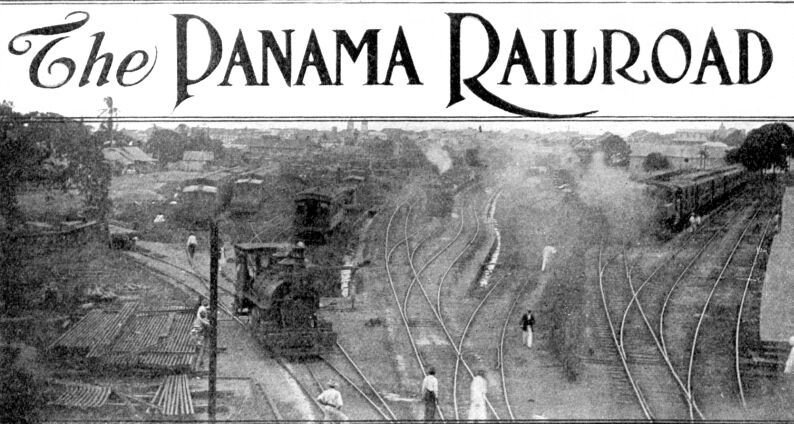
FROM 1750 to 1849, trade across the Isthmus was at a standstill,
and the old pack trails from Porto Bello and from Cruces on the
Chagres became nearly obliterated through disuse. Spain's belated
change of policy, the granting of free trade to the colonies,
came too late to be of much benefit to Panama. A few ships discharged
their cargoes at the mouth of the Chagres for transportation over
the Cruces trail, but there were no adequate facilities for handling
any great amount of trade had there been any. What little trade
there was went around Cape Horn or via the Cape of Good Hope.
The Isthmus became a place of so little importance that it was
reduced from a viceregency in 1718, when it became a province
of New Granada (the old name for Colombia). It obtained its independence
from Spain on September 26, 1821.
In 1849, however, the Isthmus again came to life with the steady
flow of emigrants bound for California, where gold had been discovered
during the previous year. California and Oregon had also been
thrown open to settlement, and the Isthmian transit became almost
a necessity, for the only other means of communication with those
states were the long overland journey by wagon train across the
American continent, and the long voyage around South America.
Thus the Isthmus as a trade route again came to the front.
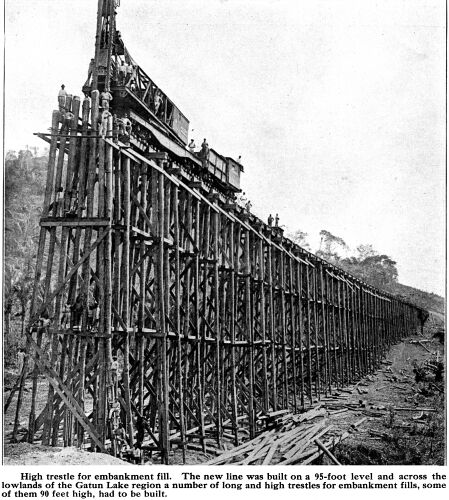 The advantages of an Isthmian
railroad as a means of developing the trade of the United States
with the growing republics of Central and South America was realized
as early as 1835, when President Andrew Jackson appointed Mr.
Charles Biddle as a commissioner to visit the different routes
best adapted for interoceanic communication by rail or by water
between the two oceans. Mr. Biddle visited the Isthmus, went to
Bogota, and obtained from the Government of New Granada a concession
for constructing a railroad across the American Isthmus. He returned
to the United States in 1837 with this document, but died before
he was able to prepare a report, so nothing further was done at
that time. In 1847, a French syndicate, headed by Mateo Kline
obtained a similar concession, but was unable to raise the money
necessary to carry out the work. In December, 1848, three far-sighted
Americans, William H. Aspinwall, Henry Chauncey, and John L. Stephens,
entered into a contract with New Granada to build the road, and
the Panama Railroad Company, with a capitalization of $1,000,000,
was incorporated under a charter granted in the state of New York.
Aspinwall, in the same year, obtained from Congress a contract
for carrying United States mail by steamer from Panama to California
and Oregon, as a part of his railroad scheme. A similar mail contract
authorized by Congress on the Atlantic side, New York and New
Orleans to Chagres, was obtained at the same time by Mr. George
Law. The advantages of an Isthmian
railroad as a means of developing the trade of the United States
with the growing republics of Central and South America was realized
as early as 1835, when President Andrew Jackson appointed Mr.
Charles Biddle as a commissioner to visit the different routes
best adapted for interoceanic communication by rail or by water
between the two oceans. Mr. Biddle visited the Isthmus, went to
Bogota, and obtained from the Government of New Granada a concession
for constructing a railroad across the American Isthmus. He returned
to the United States in 1837 with this document, but died before
he was able to prepare a report, so nothing further was done at
that time. In 1847, a French syndicate, headed by Mateo Kline
obtained a similar concession, but was unable to raise the money
necessary to carry out the work. In December, 1848, three far-sighted
Americans, William H. Aspinwall, Henry Chauncey, and John L. Stephens,
entered into a contract with New Granada to build the road, and
the Panama Railroad Company, with a capitalization of $1,000,000,
was incorporated under a charter granted in the state of New York.
Aspinwall, in the same year, obtained from Congress a contract
for carrying United States mail by steamer from Panama to California
and Oregon, as a part of his railroad scheme. A similar mail contract
authorized by Congress on the Atlantic side, New York and New
Orleans to Chagres, was obtained at the same time by Mr. George
Law.
As soon as the concession was obtained from New Granada, Mr.
Stephens, accompanied by Mr. J. L. Baldwin, an engineer, went
over the proposed route for the road and, finding a summit pass
of a little less than 300 feet, decided that it was feasible.
In the early part of 1849, a party of engineers in charge of Colonel
G. H. Hughes of the United States Topographical Corps., 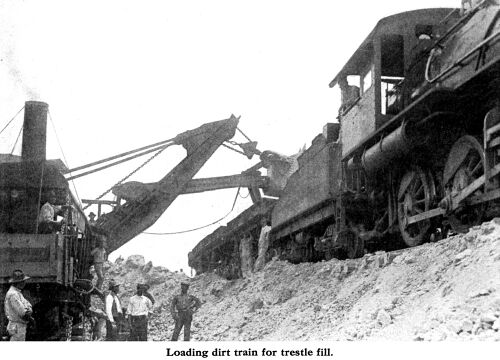 was sent to locate the line. Finding a summit
ridge of 287 feet, a line was laid out not exceeding 50 miles
in length from ocean to ocean, with the Atlantic terminus on Navy
Bay, as Limon Bay was formerly called, and with the Pacific terminus
in Panama City. was sent to locate the line. Finding a summit
ridge of 287 feet, a line was laid out not exceeding 50 miles
in length from ocean to ocean, with the Atlantic terminus on Navy
Bay, as Limon Bay was formerly called, and with the Pacific terminus
in Panama City.
A contract was then entered into with two experienced contractors,
Colonel Geo. M. Totten and John C. Trautwine, for the construction
of the line. These men decided upon Gorgona, on the Chagres river,
31 miles from Colon, as the base of operations toward Panama,
thinking that material could be easily landed there by boat. However,
the river was so low in the dry season and so swift in the rainy
season that light draft steamers were found out of the question
for the transportation of railroad material. At the same time
the increasing rush to the California gold fields by way of the
Isthmus, made river transportation and the cost of labor prohibitive,
and the contractors begged the company to release them from their
obligation. This the company did, and, deciding to undertake the
construction work itself, retained Messrs. Totten and Trautwine
in its service.
FIRST WORK ON THE PANAMA RAILROAD
 Clearing on Manzanillo Island
began in May, 1850. This was a low swampy plot of land of about
600 acres separated from the mainland by a narrow arm of the sea,
and is the site of the present city of Colon. Although clearings
had been made, residence upon the island was impossible and for
the first few months the men engaged in making the surveys, and
the laborers brought from Cartagena, Colombia, were obliged to
live on board an old brig anchored in the bay. When this became
overcrowded, as additions were made to the force, it was supplemented
by the hull of a condemned steamboat. The village of Aspinwall
was founded on February 2, 1852, but on account of Colombia's
refusal to recognize the name, it was later rechristened Colon,
in honor of Columbus. Clearing on Manzanillo Island
began in May, 1850. This was a low swampy plot of land of about
600 acres separated from the mainland by a narrow arm of the sea,
and is the site of the present city of Colon. Although clearings
had been made, residence upon the island was impossible and for
the first few months the men engaged in making the surveys, and
the laborers brought from Cartagena, Colombia, were obliged to
live on board an old brig anchored in the bay. When this became
overcrowded, as additions were made to the force, it was supplemented
by the hull of a condemned steamboat. The village of Aspinwall
was founded on February 2, 1852, but on account of Colombia's
refusal to recognize the name, it was later rechristened Colon,
in honor of Columbus.
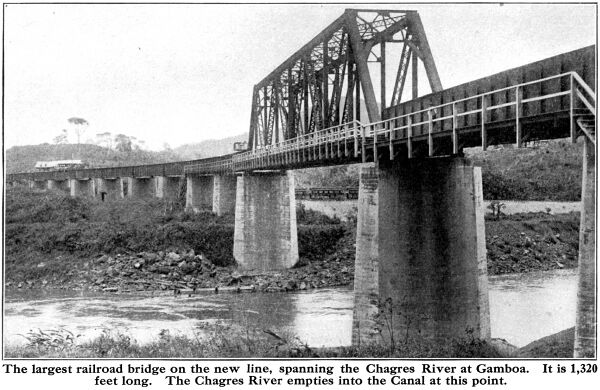 The first seven miles of the
road was through an extensive swamp, covered with jungle, and
the surveyors were compelled to work in water and slime up to
their waists. In a short time the entire force suffered with malarial
fever, and great difficulty was experienced in obtaining sufficient
laborers. Irishmen were brought from the United States, negros
from Jamaica, and natives from the adjacent tropical countries,
and fever made inroads on all of them. The importation of Chinese
coolies was tried, and nearly 1,000 of that race were brought
from China. Native hill rice, tea, and opium were supplied them,
but within a few weeks disease broke out among them, and, many
becoming melancholy, are said to have committed suicide, so that
inside of 60 days scarcely 200 able-bodied remained. The high
mortality of these Chinese laborers, probably helped develop the
story that each of the ties on the original Panama railroad represented
the life of a laborer. The facts in the case make the story ridiculous.
There were at least 150,000 cross-ties in the original road, including
sidings and yards, while the largest number of employees at any
one time was not over 7,000, and the road was completed in four
years. According to the most authentic records, the total mortality
during the construction period was about 1,200. Added to the difficulties
of maintaining a labor force, was the necessity of bringing nearly
all food and supplies from New York, a distance of nearly 2,000
miles. The first seven miles of the
road was through an extensive swamp, covered with jungle, and
the surveyors were compelled to work in water and slime up to
their waists. In a short time the entire force suffered with malarial
fever, and great difficulty was experienced in obtaining sufficient
laborers. Irishmen were brought from the United States, negros
from Jamaica, and natives from the adjacent tropical countries,
and fever made inroads on all of them. The importation of Chinese
coolies was tried, and nearly 1,000 of that race were brought
from China. Native hill rice, tea, and opium were supplied them,
but within a few weeks disease broke out among them, and, many
becoming melancholy, are said to have committed suicide, so that
inside of 60 days scarcely 200 able-bodied remained. The high
mortality of these Chinese laborers, probably helped develop the
story that each of the ties on the original Panama railroad represented
the life of a laborer. The facts in the case make the story ridiculous.
There were at least 150,000 cross-ties in the original road, including
sidings and yards, while the largest number of employees at any
one time was not over 7,000, and the road was completed in four
years. According to the most authentic records, the total mortality
during the construction period was about 1,200. Added to the difficulties
of maintaining a labor force, was the necessity of bringing nearly
all food and supplies from New York, a distance of nearly 2,000
miles.
By the first of October, 1851, the track had been laid as far
as Gatun, and in the following month, 1,000 passengers were carried
to that station from Colon. These passengers had arrived at Chagres
for the California transit in two ships, but could not be landed
there on account of a heavy storm, and were disembarked at Colon.
This happened most opportunely for the railroad, as the original
million dollars had been expended and things were beginning to
look dark to the stockholders. When the news reached New York
that passengers had been carried as far as Gatun, seven miles
by rail, even though they had been carried on flat cars, the company's
stock immediately rose in price. The work was pushed on with renewed
vigor, for, from this time on, there was a small and steady income
which could be applied to the construction expense. In July, 1852,
the road had reached Barbacoas, a total distance of 23 miles,
where it was necessary to construct a bridge 800 feet long to
span the Chagres.
On October 10, Mr. John L. Stephens, who was president of the
company, died in New York, and his successor, Mr. W. C. Young,
decided to have the remainder of the work accomplished by contract.
The contractor, however, failed to fulfill his obligation and
after a year's delay, the company again decided to do the work.
COMPLETION OF THE ENTERPRISE
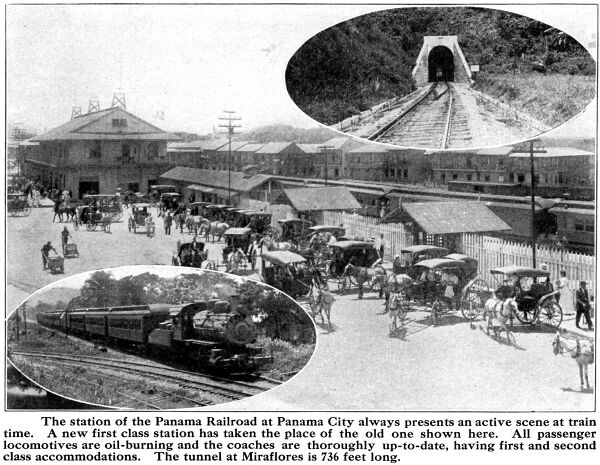 On the 27th of January, 1855,
at, midnight and in rain, the last rail to the summit ridge at
Culebra, 37 miles from Colon and 11 miles from Panama, was laid,
and in the meantime, work had been advancing steadily from Panama
city, to which point material had been transported around Cape
Horn. On the following day, the first locomotive passed from ocean
to ocean, nearly four years after ground was first broken. The
completed road was 47 miles 3,020 feet long, with a maximum grade
of 60 feet to the mile, in order to surmount the summit ridge
at elevation 287 feet. The first president was Mr. David Hoadley. On the 27th of January, 1855,
at, midnight and in rain, the last rail to the summit ridge at
Culebra, 37 miles from Colon and 11 miles from Panama, was laid,
and in the meantime, work had been advancing steadily from Panama
city, to which point material had been transported around Cape
Horn. On the following day, the first locomotive passed from ocean
to ocean, nearly four years after ground was first broken. The
completed road was 47 miles 3,020 feet long, with a maximum grade
of 60 feet to the mile, in order to surmount the summit ridge
at elevation 287 feet. The first president was Mr. David Hoadley.
Although track had been laid from ocean to ocean, the railroad
was in poor physical condition, and it was not until 1859 that
its construction account was finally closed, at a total expenditure
up to that time of $8,000,000. The road was properly ballasted,
heavier rails were laid, using hardwood ties, bridges of iron
replaced flimsy wooden structures, and station buildings and wharves
were erected. To cross waterways, 170 bridges and culverts had
been built and the wooden bridge at Barbacoas was replaced by
one of iron.
The road was a paying investment from the time when the first
11 miles were opened in 1852, for, as new sections were built
they were put into immediate service for passengers and freight,
and at the end of 1855, the year the entire road was opened, its
income from passengers and freight was $2,125,232.31. When the
original construction account was closed in January, 1859, the
gross earnings amounted to $8,146,605.00, while operating expenses,
together with depreciation amounted to $2,174,876.51, leaving
a balance of $5,971,728.66, as legitimate earnings for a period
of seven years, during the last four of which the road was open
throughout its entire length. Dividends have been paid every year
on the stock, with the exception of a few years previous to the
taking over of the road from the French Canal Company by the United
States. The average dividend during the years 1852-1881 was 16
per cent., and since that period, five per cent; the smallest
dividend was two per cent. in 1885, and the largest 44 per cent.
in 1868. In 1865, the capital stock was increased from $5,000,000
to $'7,000,000. In 1881, the year when the road was sold to the
French Canal Company, a dividend of 52½ per cent. was declared,
but this not only represented the earnings for that year, but
also included the assets and surplus on hand at that time.
EARLY RATES NEARLY PROHIBITIVE
The following table of rates, placed in effect when the road
was first opened in 1855, remained in force for 20 years, and
following the company's policy, were intended to be prohibitive
at first, on the theory that they would be lowered when the company
had had an opportunity to improve its line, will explain in a
measure the large profits made on this road which cost about $170,000
a mile to build:

At the present time the first-class passenger fare is $2.40,
with 150 pounds of baggage free; second-class, half of that rate.
ESTABLISHMENT OF STEAMSHIP SERVICE
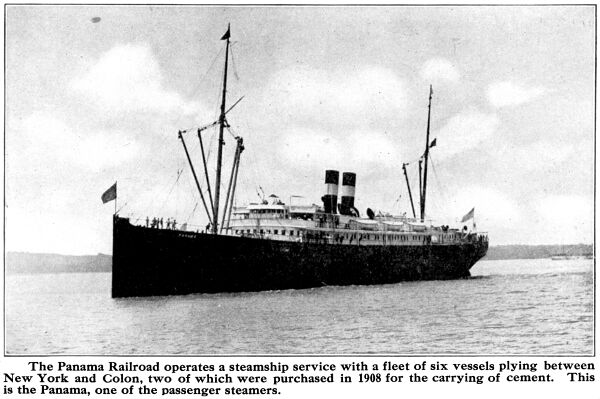 In 1856, the company established
a steamship service between Panama and San Jose de Guatemala,
thus opening up the rich coffee country of Central America. This
line continued until October, 1872, when it was taken over by
the Pacific Mail Steamship Company. At one time the road had a
line of its own between San Francisco and Panama, but this was
withdrawn in 1902. In 1893, the present Panama Railroad Steamship
Line was established between New York and Colon, and there are
now six ships in this service, the Ancon, Cristobal, Panama,
Colon, Allianca and Advance, although the two former
vessels purchased in 1908 are owned by the Canal Commission, and
have been used mainly in transporting cement to the Isthmus. In 1856, the company established
a steamship service between Panama and San Jose de Guatemala,
thus opening up the rich coffee country of Central America. This
line continued until October, 1872, when it was taken over by
the Pacific Mail Steamship Company. At one time the road had a
line of its own between San Francisco and Panama, but this was
withdrawn in 1902. In 1893, the present Panama Railroad Steamship
Line was established between New York and Colon, and there are
now six ships in this service, the Ancon, Cristobal, Panama,
Colon, Allianca and Advance, although the two former
vessels purchased in 1908 are owned by the Canal Commission, and
have been used mainly in transporting cement to the Isthmus.
CONCESSIONARY RIGHTS AND PRIVILEGES
The terms of the original concession granted by the Government
of New Granada provided, among other things, the exclusive privilege
of building a railroad on the Isthmus of Panama; that no undertaking
for the opening of a canal to connect the two oceans would be
permitted without the consent of the railroad company; that the
railroad company should have the exclusive privilege of building
wagon roads across the Isthmus and the use of the Chagres for
steamer travel, and the exclusive privilege of the use of the
ports at the two termini for the anchorage of vessels, and for
the loading and unloading of cargo.
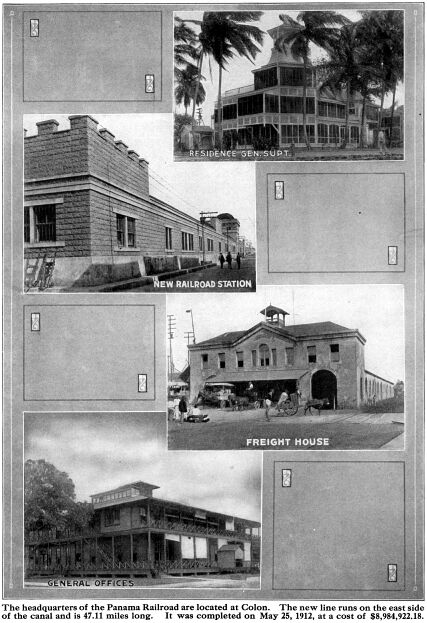 This concession was to remain
in force 49 years from the day of the road's completion, subject
to the right of New Granada to take possession at the expiration
of 20 years upon the payment of $5,000,000, or at the expiration
of 40 years upon the payment of $2,000,000. The provisions of
the contract were modified several times, but its exclusive features
remained practically the same. In 1867, it was renewed for 99
years on payment of $1,000,000 in cash, and an annual payment
of $250,000 guaranteed to New Granada. The railroad also obligated
itself to extend the road to the islands in the bay of Panama.
This extension of the contract for 99 years was secured 12 years
after the opening of the road by Colonel Totten, when it was realized
that New Granada would surely raise the necessary $5,000,000 to
obtain the road after 20 years of operation, a road costing $8,000,000
to build and, at that time paying 24 per cent on a capitalization
of $7,000,000. This concession was to remain
in force 49 years from the day of the road's completion, subject
to the right of New Granada to take possession at the expiration
of 20 years upon the payment of $5,000,000, or at the expiration
of 40 years upon the payment of $2,000,000. The provisions of
the contract were modified several times, but its exclusive features
remained practically the same. In 1867, it was renewed for 99
years on payment of $1,000,000 in cash, and an annual payment
of $250,000 guaranteed to New Granada. The railroad also obligated
itself to extend the road to the islands in the bay of Panama.
This extension of the contract for 99 years was secured 12 years
after the opening of the road by Colonel Totten, when it was realized
that New Granada would surely raise the necessary $5,000,000 to
obtain the road after 20 years of operation, a road costing $8,000,000
to build and, at that time paying 24 per cent on a capitalization
of $7,000,000.
Two years later, 1869, the Union Pacific was completed across
the American continent, with a consequent decline of California
trade across the Isthmus. . The loss of this trade would have
been offset by the trade of Central and South America, had the
company seized the opportunity, but its policy, apparently, was
to make all it could there and then let the future take care of
itself. In 1868, the Pacific Steam Navigation Company withdrew
its line of steamers from the Isthmian transit, and sent its ships
to England via the Strait of Magellan, and transferred its repair
shops and coaling station from the island of Taboga to Callao,
Peru. It was forced to do this by the shortsighted policy of the
railroad's directors who refused to ratify a traffic agreement
profitable to both, which had been tentatively drawn up, giving
the company where freight originated the right to make a through
charge to be divided equally between the three carriers, the railroad
and the steamship lines on either side of the Isthmus. The steamship
company took most of its trade with it and an idea of what was
lost to the railroad can be obtained from the fact that, in 1874,
it had 54 steamers, with a total of 124,000 tons, in operation
between Valparaiso and Liverpool. Only its smaller boats were
sent to Panama, and these merely to act as feeders to the main
line on their return south. This policy of offering no encouragement
to steamship lines also forced the Panama, New Zealand and Australian
Steamship Company to give up its attempt to inaugurate a monthly
service via Wellington to Sydney, connecting with the Royal Mail
Steam Packet Company, operating between Southampton and Colon.
In spite of this policy of taking more than the trade could
stand, the railroad continued to pay dividends, but it would undoubtedly
have done a much more profitable business had it endeavored to
help, instead of oppressing the growing trade of Central and South
America.
CHANGES IN OWNERSHIP
When the French operations were begun in 1881, the French Canal
Company found that in order to build a canal it would first have
to gain the consent of the railroad or to purchase it. The latter
plan was followed, and in June of that year, 68,888 of the 70,000
shares were obtained for a little over $20,000,000 or two and
one-half times what the road had originally cost to build. 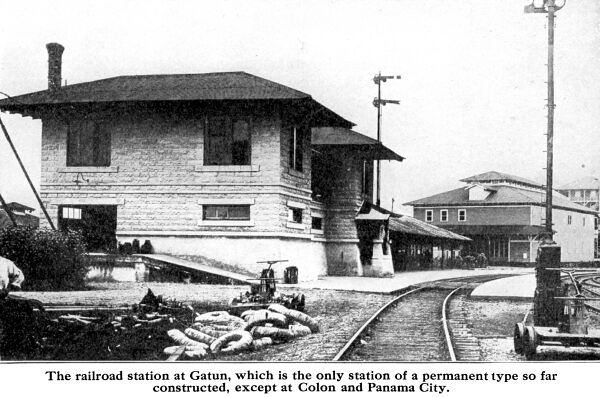 In addition to the amount expended for shares,
bonuses paid brought the total cost to a little over $25,000,000.
When the United States, on May 4, 1904, took over the affairs
of the New French Canal Company, they came into possession of
these shares, and obtained the remainder, 1,112 shares, by private
purchase at a cost of $157,118.24, or an average price of $140.00
per share. The entire stock of the Panama Railroad and Steamship
Company is now owned by the United States, with the exception
of one share transferred to each of the directors to enable them
to qualify under the articles of incorporation. The Chairman and
Chief Engineer of the Isthmian Canal Commission is also President
of the Panama Railroad Company. In addition to the amount expended for shares,
bonuses paid brought the total cost to a little over $25,000,000.
When the United States, on May 4, 1904, took over the affairs
of the New French Canal Company, they came into possession of
these shares, and obtained the remainder, 1,112 shares, by private
purchase at a cost of $157,118.24, or an average price of $140.00
per share. The entire stock of the Panama Railroad and Steamship
Company is now owned by the United States, with the exception
of one share transferred to each of the directors to enable them
to qualify under the articles of incorporation. The Chairman and
Chief Engineer of the Isthmian Canal Commission is also President
of the Panama Railroad Company.
Since it has become a government-owned corporation, the road
has become secondary to the Canal work, although it is still a
common carrier, and carries about 70,000 tons of commercial freight
a month, which is about one-half of the total amount, the balance
being handled for the company and for the Canal work.
When the road was turned over by the French it was found to
be in a neglected condition, with obsolete equipment and rolling
stock. Since that time terminal wharves, equipped with modern
cargo cranes, have been constructed, terminal yards, warehouses
and machine shops provided, new and powerful locomotives, 12 of
which are oil burners, larger cars for passengers and freight
put into service, heavier rails laid, bridges strengthened to
enable them to carry the heavier equipment, and the whole line
double-tracked. Permanent reinforced concrete stations have been
built at Colon, Gatun and Panama, and a modern concrete hotel,
the Washington, costing upwards of $650,000 has been constructed
on Colon beach.
THE NEW MAIN LINE
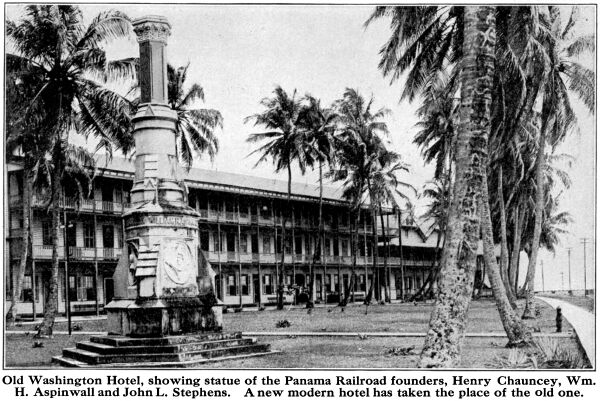 The relocated, or new main line
of the railroad runs on the east side of the canal for its entire
length of 47.11 miles. From Colon to Mindi, 4.17 miles, and from
Corozal to Panama, the old location was used, but the remaining
40 miles are new road. From Gatun, the line skirts the north shore
of the lake for about four miles, and then turns south, crossing
the eastern arm of the lake on a high trestle fill at an elevation
of 95 feet above sea level. Near Caimito, the road approaches
the canal again, and parallels it to Gamboa. Originally, it was
planned to carry the road through Culebra Cut on a 40-foot berm,
10 feet above the water level, but slides caused the abandonment
of the project, and it was built on a high level around Gold Hill
instead. Its highest point is 271 feet above sea level near LaPita,
and where the continental divide is crossed, opposite Culebra,
the height is 241 feet. From the south end of Culebra Cut at Paraiso,
the railroad runs practically parallel with the canal to Panama.
Where the road crosses the Gatun River, near Monte Lirio, a steel
girder bridge with a lift span has been erected to permit native
sailing craft to pass into the east arm of the lake, and at Gamboa,
the Chagres River is crossed with a steel girder bridge one-quarter
of a mile long. At Miraflores, the road passes through a tunnel
736 feet long. The relocated, or new main line
of the railroad runs on the east side of the canal for its entire
length of 47.11 miles. From Colon to Mindi, 4.17 miles, and from
Corozal to Panama, the old location was used, but the remaining
40 miles are new road. From Gatun, the line skirts the north shore
of the lake for about four miles, and then turns south, crossing
the eastern arm of the lake on a high trestle fill at an elevation
of 95 feet above sea level. Near Caimito, the road approaches
the canal again, and parallels it to Gamboa. Originally, it was
planned to carry the road through Culebra Cut on a 40-foot berm,
10 feet above the water level, but slides caused the abandonment
of the project, and it was built on a high level around Gold Hill
instead. Its highest point is 271 feet above sea level near LaPita,
and where the continental divide is crossed, opposite Culebra,
the height is 241 feet. From the south end of Culebra Cut at Paraiso,
the railroad runs practically parallel with the canal to Panama.
Where the road crosses the Gatun River, near Monte Lirio, a steel
girder bridge with a lift span has been erected to permit native
sailing craft to pass into the east arm of the lake, and at Gamboa,
the Chagres River is crossed with a steel girder bridge one-quarter
of a mile long. At Miraflores, the road passes through a tunnel
736 feet long.
The new line was completed on May 25, 1912, at a cost of $8,984,922.18,
but passenger trains were not run over it for its entire length
until September 2, 1913, when the former crossing at Gamboa dike
was abandoned on account of the rise of  Gatun
Lake. On that date a new schedule was placed in effect, whereby
the main line trains run all the way from Colon to Panama on the
east side of the canal, and the towns on the west bank are served
with a shuttle train service from Panama to Bas Obispo, the present
terminus of the old double-track line. The shuttle trains now
cross the canal, near Paraiso on a trestle bridge, but as this
will have to be removed to permit the navigation of the canal,
a wooden pontoon bridge will be built in the same locality of
sufficient width for a single track and a roadway for vehicles.
This is not intended for a permanent crossing but only to such
time as the villages on the west bank of the canal can be abandoned.
South of Corozal, a change will be made in the road which will
have the effect of placing the new town of Balboa on the main
line, with its terminus at Panama as at present. The railroad
possesses modern passenger terminals at both ends. The one in
Colon is of concrete block construction, and was opened on July
23, 1909. It is not particularly attractive from an architectural
standpoint. The new station in Panama, costing about $100,000,
was completed in the latter part of 1913. The only other station
of a permanent type so far constructed is at Gatun, built in 1909. Gatun
Lake. On that date a new schedule was placed in effect, whereby
the main line trains run all the way from Colon to Panama on the
east side of the canal, and the towns on the west bank are served
with a shuttle train service from Panama to Bas Obispo, the present
terminus of the old double-track line. The shuttle trains now
cross the canal, near Paraiso on a trestle bridge, but as this
will have to be removed to permit the navigation of the canal,
a wooden pontoon bridge will be built in the same locality of
sufficient width for a single track and a roadway for vehicles.
This is not intended for a permanent crossing but only to such
time as the villages on the west bank of the canal can be abandoned.
South of Corozal, a change will be made in the road which will
have the effect of placing the new town of Balboa on the main
line, with its terminus at Panama as at present. The railroad
possesses modern passenger terminals at both ends. The one in
Colon is of concrete block construction, and was opened on July
23, 1909. It is not particularly attractive from an architectural
standpoint. The new station in Panama, costing about $100,000,
was completed in the latter part of 1913. The only other station
of a permanent type so far constructed is at Gatun, built in 1909.
The total mileage of the road, exclusive of sidings, is 58.79,
as follows: Main line, 47.11 miles; Pedro Miguel to Bas Obispo,
9.12, miles, and Panama to Balboa 2.56 miles.
BUSIEST SHORT LINE IN THE WORLD
During the years 1911-1912 the road carried 777,121 first-class
passengers, and 1,980,550 second-class passengers, an increase
of over 300,000 for the year. During the fiscal year just closed,
the passenger traffic is expected to show material increase due
in part to the increased tourist travel. Freight amounting to
1,871,076 tons was transported over the railroad during 1911-1912,
divided as follows:

The net revenue from its operation was $1,997,280.80. The steamship
line, on the other hand, has not paid as an investment, except
as a feeder for the railroad, and for the benefit of the Isthmian
Canal Commission. It has had a steady freight and passenger traffic,
but the cargoes have consisted principally of canal supplies,
and the passengers have been mostly employees of the Canal Commission
and railroad, who are carried at a reduced rate. The net deficit
from the operation of the steamship line for the fiscal year ending
June 30, 1912, was $305,742.85.
 With the completion of the canal
it is possible that the road will be electrified, obtaining the
necessary power from the hydroelectric plant at Gatun spillway,
and will be devoted almost entirely to local traffic. This traffic
will, no doubt, be considerable, for Colon and Panama will always
be important cities. With the completion of the canal
it is possible that the road will be electrified, obtaining the
necessary power from the hydroelectric plant at Gatun spillway,
and will be devoted almost entirely to local traffic. This traffic
will, no doubt, be considerable, for Colon and Panama will always
be important cities.
Panama Canal
| Contents Page
|







